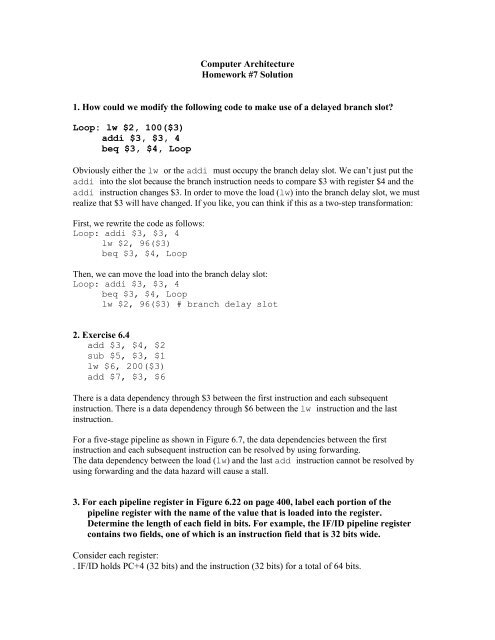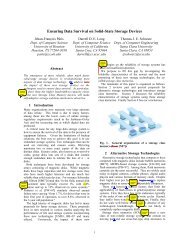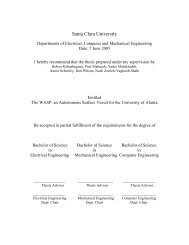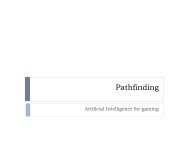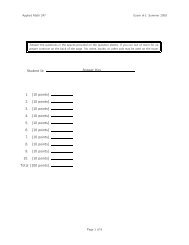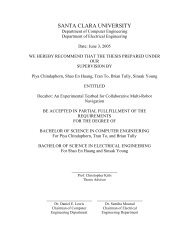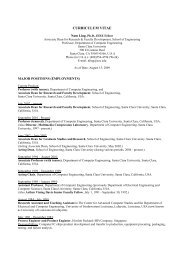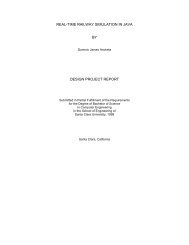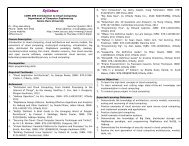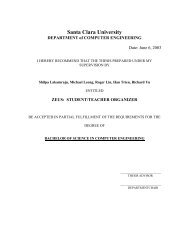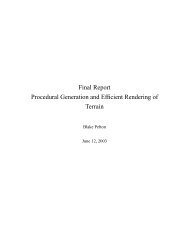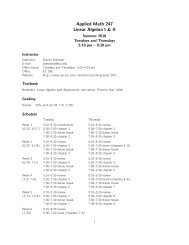Computer Architecture Homework #7 Solution 1. How could we ...
Computer Architecture Homework #7 Solution 1. How could we ...
Computer Architecture Homework #7 Solution 1. How could we ...
Create successful ePaper yourself
Turn your PDF publications into a flip-book with our unique Google optimized e-Paper software.
<strong>Computer</strong> <strong>Architecture</strong><br />
<strong>Homework</strong> <strong>#7</strong> <strong>Solution</strong><br />
<strong>1.</strong> <strong>How</strong> <strong>could</strong> <strong>we</strong> modify the following code to make use of a delayed branch slot?<br />
Loop: lw $2, 100($3)<br />
addi $3, $3, 4<br />
beq $3, $4, Loop<br />
Obviously either the lw or the addi must occupy the branch delay slot. We can’t just put the<br />
addi into the slot because the branch instruction needs to compare $3 with register $4 and the<br />
addi instruction changes $3. In order to move the load (lw) into the branch delay slot, <strong>we</strong> must<br />
realize that $3 will have changed. If you like, you can think if this as a two-step transformation:<br />
First, <strong>we</strong> rewrite the code as follows:<br />
Loop: addi $3, $3, 4<br />
lw $2, 96($3)<br />
beq $3, $4, Loop<br />
Then, <strong>we</strong> can move the load into the branch delay slot:<br />
Loop: addi $3, $3, 4<br />
beq $3, $4, Loop<br />
lw $2, 96($3) # branch delay slot<br />
2. Exercise 6.4<br />
add $3, $4, $2<br />
sub $5, $3, $1<br />
lw $6, 200($3)<br />
add $7, $3, $6<br />
There is a data dependency through $3 bet<strong>we</strong>en the first instruction and each subsequent<br />
instruction. There is a data dependency through $6 bet<strong>we</strong>en the lw instruction and the last<br />
instruction.<br />
For a five-stage pipeline as shown in Figure 6.7, the data dependencies bet<strong>we</strong>en the first<br />
instruction and each subsequent instruction can be resolved by using forwarding.<br />
The data dependency bet<strong>we</strong>en the load (lw) and the last add instruction cannot be resolved by<br />
using forwarding and the data hazard will cause a stall.<br />
3. For each pipeline register in Figure 6.22 on page 400, label each portion of the<br />
pipeline register with the name of the value that is loaded into the register.<br />
Determine the length of each field in bits. For example, the IF/ID pipeline register<br />
contains two fields, one of which is an instruction field that is 32 bits wide.<br />
Consider each register:<br />
. IF/ID holds PC+4 (32 bits) and the instruction (32 bits) for a total of 64 bits.
. ID/EX holds PC+4 (32 bits), Read data 1 and 2 (32 bits each), the sign-extended data (32<br />
bits), and two possible destinations (5 bits each) for a total of 138 bits.<br />
. EX/MEM holds PC target if branch (32 bits), Zero (1 bit), ALU Result (32 bits), Read data<br />
2 (32 bits), and a destination register (5 bits) for a total of 102 bits.<br />
. MEM/WB holds the data coming out of memory (32 bits), ALU Result (32 bits), and the<br />
destination register (5 bits) for a total of 69 bits.<br />
Note: It is OK to add control bits and have slightly different ans<strong>we</strong>rs.<br />
. Control signals for EX stage (RegDst, ALUOp1, ALUOp0, and ALUSrc) = 4 bits<br />
. Control signals for MEM stage (Branch, MemRead, and MemWrite) = 3 bits<br />
. Control signals for WB stage (RegWrite, MemtoReg) = 2 bits<br />
So<br />
. IF/ID = 64 bits<br />
. ID/EX = 138 + 4 + 3 + 2 = 147 bits<br />
. EX/MEM = 102 + 3 + 2 = 107 bits<br />
. MEM/WB = 69 + 2 = 71 bits<br />
4. Exercise 6.18<br />
add $2, $3, $1<br />
sub $4, $3, $5<br />
add $5, $3, $7<br />
add $7, $6, $1<br />
add $8, $2, $6<br />
The forwarding unit is seeing if it needs to forward. It is looking at the instructions in the fourth<br />
and fifth stages and checking to see whether they intend to write to the register file and whether<br />
the register written is being used as an ALU input. Thus, it is comparing $3 = $4? $3 = $2? $7 =<br />
$4? $7 = $2?<br />
5. Exercise 6.19<br />
The hazard detection unit is checking to see whether the instruction in the ALU stage is an lw<br />
instruction and whether the instruction in the ID stage is reading the register that the lw will be<br />
writing. If it is, it needs to stall. If there is an lw instruction, it checks to see whether the<br />
destination is register 6 or 1 (the registers being read).
6. Exercise 6.22<br />
It will take 8 cycles to execute this code, including a bubble of 1 cycle due to the dependency<br />
bet<strong>we</strong>en the lw and sub instructions.


